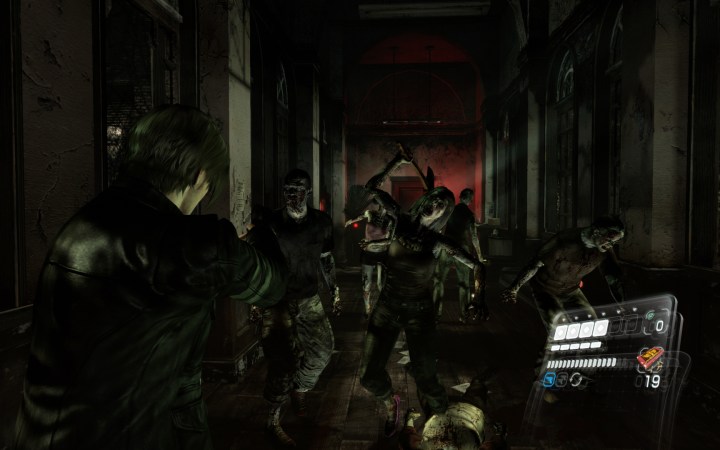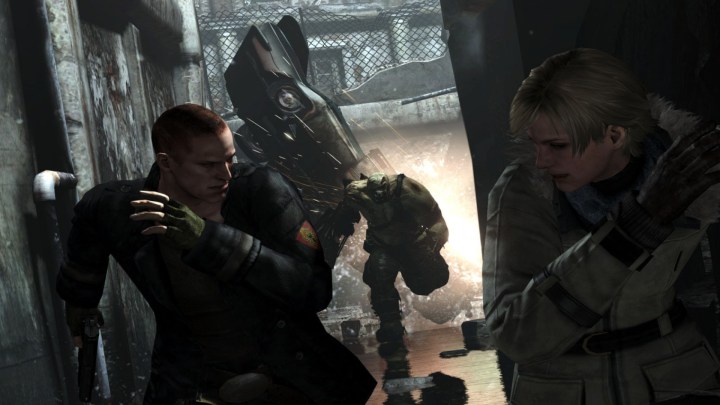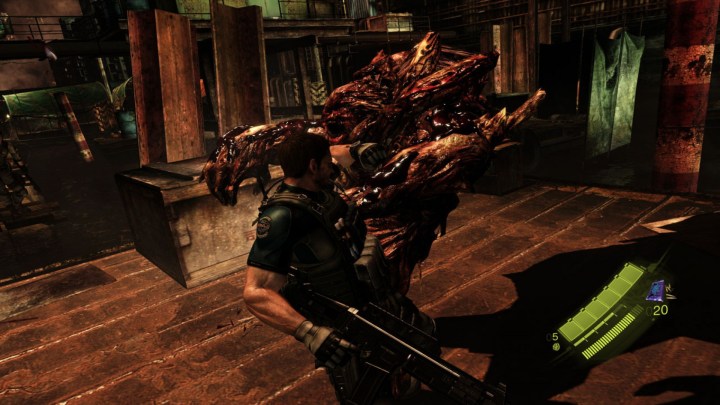In a less forgiving timeline, Resident Evil 6 could have been the final breath for gaming’s greatest horror series.
Coming off the critically (and ethically) panned Resident Evil 5, the franchise’s sixth mainline installment is widely considered its worst. The title would move entirely away from the series’ signature puzzle box horror in favor of a fast-paced action game with an over reliance on cinematic quick-time events. That departure, coupled with sloppy execution, would leave a sour taste in players’ mouths. The game would launch in 2012 to mediocre reviews and fail to hit the lofty sales expectations Capcom set for it. It felt like the series was one bad investors’ call away from a “You Are Dead” screen.
Its reputation was so immediately poisoned that I didn’t have the heart to play it when it launched. As someone who grew up loving the series, I was disheartened to see a once-trendsetting series lose its identity. It didn’t just feel like a loss for Resident Evil, but one for the gaming industry as a whole, as it seemed to be trading in what made it special to try and replicate Hollywood.
It took a decade (and easy access to the game via PS Plus) for me to work up the courage to finally play it. And once I did, I was shocked by what I found: that for all its obvious flaws, it’s kind of a blast. Yes, Resident Evil 6 is a total mess, but it’s a misunderstood game that deserves relitigating now that it’s removed from the expectations hung on it in 2012. It may not feel like a classic Resident Evil game, but in many respects, it’s the most Resident Evil game there is.
Roundhouse kicks
Much of the criticism lobbied against Resident Evil 6 is earned — even a fresh 2016 remaster couldn’t cover up its blemishes. It’s uncharacteristically sloppy for a major franchise release of this scale, one that I can’t believe made it past Capcom quality control. Its controls are confounding, the unforgiving quick-time actions are a literal pain to execute, and there’s a healthy serving of “jank” that makes everything feel even more unwieldy.
All of those issues (and, trust me, so many more) all put a hazy filter over an otherwise memorable experience. What Resident Evil 6 has over the rest of the series is that it knows what it is right out the gate and sticks to it. It sets out to be an over-the-top action game from start to finish — and I mean that in the best possible way. That’s best typified by its wild combat, which throws the series’ slow, methodical gunplay out the window in favor of absolute mayhem. Melee attacks play a much bigger role in battle, as players can tap a button to punch and kick any remaining brains out of their zombie foes. Characters even utilize a full suite of wrestling moves, turning something like a German suplex into a head-exploding finishing maneuver.

Resident Evil 6’s gleefully ridiculous combat solves a problem the series still has to this day. Historically, the Resident Evil series has always struggled when it comes to balancing survival horror and action. Many games in the series begin as tense haunted house thrillers, but peter out in their final acts by ramping up the gunfights. Resident Evil 7, for instance, loses steam when it trades in the eerily secluded Baker compound for a massive boat filled with mold monsters to gun down. That pacing shift creates a challenge for developers who have to create a combat system that can function on both sides of the aisle. It often leaves games feeling disjointed, as slow shooting just doesn’t feel right in a suddenly high-octane action scene.
That’s not a problem in Resident Evil 6, as it’s the rare entry where Capcom actually commits to one genre rather than trying to awkwardly juggle two at once. Love the approach or hate it, it undoubtedly makes for a more consistent game end to end.
The real heart of Resident Evil
The decision to drop survival horror entirely made sense from a game design perspective, but it understandably left fans feeling sour at the time. After all, Resident Evil is specifically known for its tense jump scares and claustrophobic puzzle box gameplay. By trading those in for scissor kicks and quick-time events, it felt like Capcom was betraying the series’ heart to chase modern game trends.
However, Resident Evil 6 isn’t as tremendous a departure as it seems at first glance. While it does abandon the series core gameplay tenets, it understands the series’ true defining facet: its world-class shark jumping.

There are a lot of words I’d use to describe the series, but “cerebral” isn’t one of them. Resident Evil is a goofy B-movie filled with bad acting, gross-out horror, and absurd set pieces. Each game tries to one up the previous installment by making everything that much bigger, from game scope to the monsters themselves. In that sense, Resident Evil 6 is the most logical progression of the series possible. After decades of slow-simmering, it was the franchise finally boiling over in spectacular fashion.
Leon S. Kennedy’s storyline, for instance, begins with him shooting the zombified U.S. president dead. It’s a laugh-out-loud moment, as Leon melodramatically sulks over his actions like a soap opera character who’s just betrayed a lover. Chris Redfield is the star of his own war movie send-up where he fights off an army of militarized monsters. There’s even a riotously left-field boss fight against, yes, a literal shark. Each moment is more unbelievable than the last, making for a completely unpredictable gauntlet of popcorn thrills.
I’m not praising these moments ironically; Capcom is at its most playful here, embracing the series’ goofy streak. It gets that Resident Evil isn’t meant to be taken too seriously and instead functions best as a horror-melodrama hybrid. Resident Evil 6’s best strength is that it’s not overly precious about its lineage. It’s interested in escalating the series, not replicating it.
Completing the stakes
That escalation isn’t just for show. Resident Evil 6 plays an important role in the overall story of the franchise, one that pays off decades of stakes. Before 6, Resident Evil games largely focused on experiments gone awry. The overarching story revolves around the Umbrella Corporation, a shady pharmaceutical company testing out viruses on human and animal subjects. The underlying horror is that Umbrella is hoping to turn its zombie virus into a biological super weapon that could be sold to the military for a high price. It was a hollow threat, as there was always a hero to foil those plans, but it posed a scary question: What would happen if this got into the wrong hands?

Resident Evil 6 finally answers that question. A rogue group dubbed Neo-Umbrella gets ahold of the C-Virus and uses it to launch a global terrorist attack (hence the aforementioned zombie president). It results in the nightmare the series always forewarned, fully realizing its anxieties around excessive militarization. Major cities are turned into warzones stalked by a literal army of monsters. It’s everything Chris Redfield and Jill Valentine fought to stop in the Spencer Mansion.
A few aspects of previous games retroactively begin to make sense in that context. For instance, the series always had a major emphasis on animal experiments up to that point, with giant sharks and scorpions appearing as bosses. The justification was that Umbrella was testing its virus on animals, but it always felt like more of a convenient video gamey excuse to have some larger-scale fights.
However, we finally get some sensible (and silly) payoff in Resident Evil 6. Many of its C-Virus infected J’avo soldiers have been seemingly infused with animal DNA, turning them into deadlier killing machines. Noga-Trchanje are soldiers that have spider-like legs that let them quickly scuttle and pounce on enemies. When I first faced one, I thought back to fighting a giant tarantula in the first Resident Evil and thought: “So this is why Umbrella was experimenting on these.” That feeling especially comes to a head in Chris Redfield’s story, as he fights a stealth-cloaked snake – a now militarized version of a reptile he fought in the Spencer Mansion.

Resident Evil 6 is a bit like Avengers: Endgame, in that it’s a big conclusion to a sprawling story that had been building for decades. Every biological disaster comes to an explosive head in 6, as the worst-case scenario finally unfolds. It makes sense that this specific story would call for a pure action game rather than a tight horror one: This is all-out war, Umbrella’s own endgame.
There are a lot of valid reasons to dislike Resident Evil 6, but there’s a lot of (admittedly dumb) fun to be had if you go into it with recalibrated expectations now removed from the emotional turmoil surrounding its launch. While it’s not a classic puzzle box horror game full of memorable jump scares, it’s still undeniably Resident Evil through and through — mutated sharks and all.
Editors' Recommendations
- How an underdog Street Fighter 6 player beat the odds to win $1 million
- You can play as Resident Evil 4’s Leon Kennedy in Tekken 8 … sort of
- Why do we love horror games? Psychologists explain our morbid curiosity
- iPhone 15 Pro can natively run the latest Resident Evil and Assassin’s Creed games
- The best games of 2023 so far: Tears of the Kingdom, Resident Evil 4, and more



